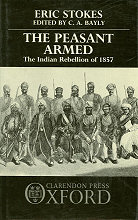
STOKES : The peasant armed (előszó)
EDITOR'S PREFACE
ERIC STOKES'S original scheme for The Peasant Armed included three chapters for which no draft material exists. These were to be studies of the revolt in 'the Lower Doab' (i.e. Fatehpur and Allahabad districts), 'Oudh and the eastern districts' (i.e. the tracts covered by the Chief Commissioner of Oudh, the Commissioner of Benares and Western Bihar in the later nineteenth century), and central India. His detailed treatment of the social origins of the revolt would therefore have extended to all regions where mutiny was complemented by civil rebellion in 1857. Stokes does not appear to have projected any separate treatment of regions where the military alone revolted, such as a number of Punjab stations, or areas where there was a good deal of elite or popular discontent which did not break into open rebellion, as in Hyderabad or parts of the Maratha territories. The work would also have culminated with a lengthy essay on colonial revolt in general, but, sadly, he had not begun to write the conclusion at the time of his death in 1981. The direction of Stokes's thought on the various regions can be partially inferred from The Peasant and the Raj (Cambridge, 1978). The introduction to this work and chapter 5—on 'traditional resistance movements'—deal briefly with Oudh and the Lower Doab, while chapter 11 has contextual material for central India. In addition, Stokes supervised nearly fifty undergraduate seminar papers for a Cambridge special subject on the rebellion in the late 1960s. These give further indications of his ideas for the missing chapters and I have suggested how he might have proceeded in my concluding note to this volume.
The lack of Eric Stokes's own conclusions is, nevertheless, a severe problem. I have tried to fill the gap by including here a seminar paper for the South Asian Institute of Heidelberg University completed in 1978 and entitled 'The Roots of Peasant Violence in the 1857 Rebellion'. In no way can this stand as a conclusion. But it does relate to one of the major issues with which he grappled, the relation between elite and mass protest, besides dealing with an area of the north Indian plains (the middle and lower Doab) not covered in the extant chapters.
A further difficulty is that chapter 3 of The Peasant Armed is unfinished. It was to be a general treatment of the north Indian agrarian economy and the British Raj, bringing up to date some of the material presented in chapter 2 of The Peasant and the Raj ('The first century of British colonial rule in India') and his chapter in the Cambridge Economic History of India (Cambridge, 1982). The chapter would presumably have gone on to deal with the lower strata of the peasantry, agricultural labourers, and possibly townsmen and artisans. Parts of this chapter have proved exceptionally difficult to reconstruct as they were in very rough draft. But it seemed essential to include them, as Eric Stokes's understanding of the society of the old peasant elite of north India—the Rajput and Brahmin village-controllers—is central to his whole analysis of the revolt.
Finally, it should be mentioned that nearly half of the references and footnotes were incomplete and impossible to trace in manuscript notes. Stokes was a very careful scholar and the quotations are almost certainly correct. But it has proved impossible to track their source down in several instances. Rather than omit all reference material in such cases, I have included as much as can be recovered so that any future research worker will at least know where to start looking.
Inevitably The Peasant Armed is an unbalanced book. The connection between the military mutiny, so interestingly treated in the first two chapters, and the detailed social analysis which exists thereafter is implicit rather than explicit. This makes the book difficult for the non-specialist to follow. But the interest and sophistication of this work made its publication imperative, even in an incomplete form.
St Catharine's College, Cambridge
July 1985
C. A. BAYLY